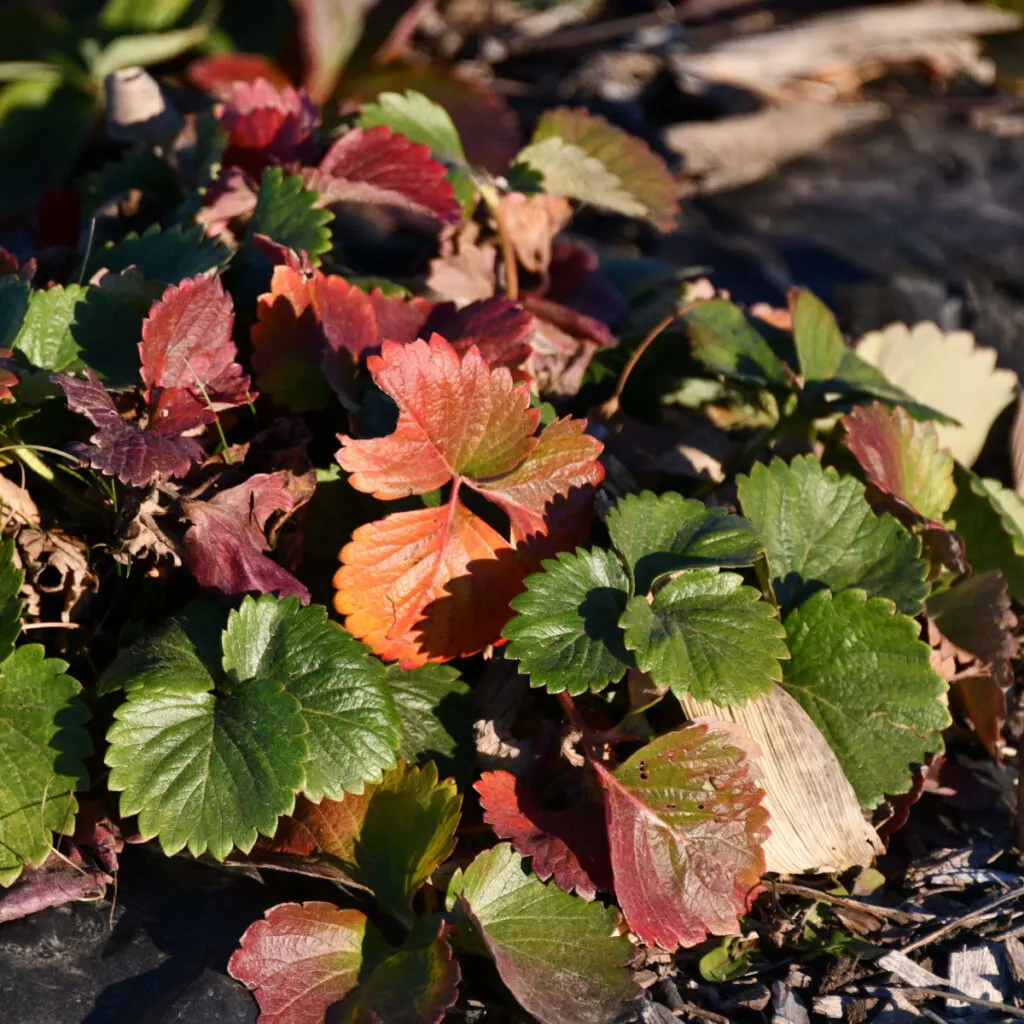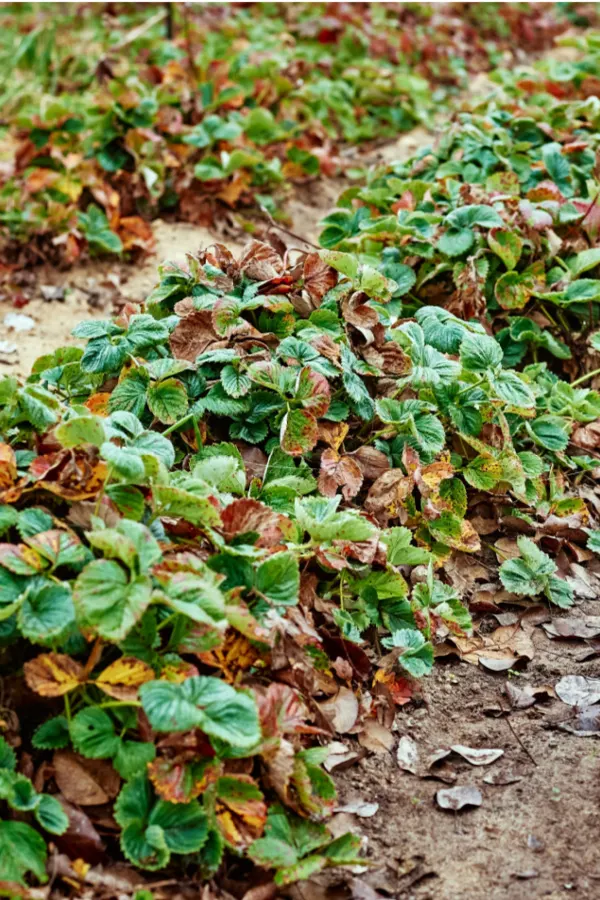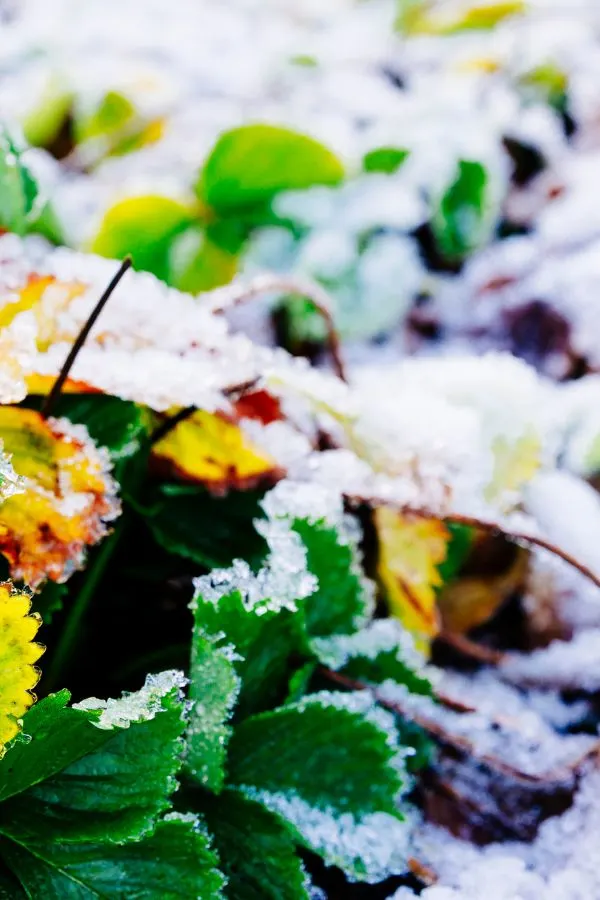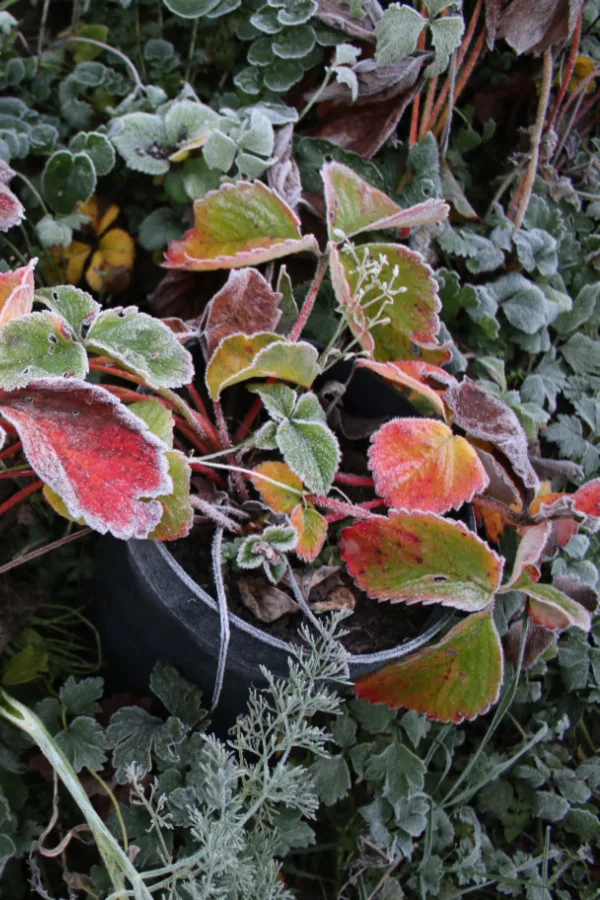Looking for a few fall care tips to to get your strawberry plants ready to handle the upcoming winter?
No matter how or where you grow your strawberries, or whether they are everbearing or June-bearing, what you do with your plants in the fall will play a pivotal role in not only how well they survive the winter, but also how healthy and productive your plants are next spring and summer.
That is true for strawberries that grow in a traditional garden, in raised beds, or in pots and containers. The fact is, when strawberry plants fail to produce, the issue can often be traced back to fall care. Sometimes it’s a lack of care – while other times it can even be too much!

Although strawberries can handle low temperatures in most climates, they do require a bit of assistance to help them through the harsh winter months. Especially if you happen to live in a climate where the temperatures can drop significantly.
Without some type of protection in place, plants growing in cold climates can not only be damaged, but in some cases, freeze completely out. And as you will see below, even when growing in moderate climates, winter protection is still important.
In addition, how you deal with a strawberry plant’s dying foliage in the fall also plays a critical role in both its winter survival as well as its production the following year as well. Seem complicated? It’s actually not. In fact, armed with just a few key tips, you can actually have your plants all ready for winter in a flash!
How To Get Strawberry Plants Ready For Winter
How you will care for your plants will depend on three factors – what type of strawberry plants you are growing, where you are growing them at, and what type of winter climate you grow them in.
Let’s start first by covering the types of strawberries, because of all three factors, it’s the most important when it comes to how you will need to prepare them for the upcoming winter.

Strawberry plants can either be everbearing or June bearing. Just as their name implies, everbearing plants produce berries all season long. And June bearing? You guessed it – they produce all of their berries at once, and usually right around June. See: The Secrets To Planting Strawberries
Everbearing strawberries are extremely versatile. They can grow in traditional garden spaces, raised beds and they also perform very well in containers. Although they produce all season long, they do so in smaller amounts throughout the season and are typically smaller berries.
June bearing plants are rarely if ever grown in pots and containers. They are typically larger plants and produce larger berries. Because they produce all at once in late spring or early summer, they are beloved by those who love to make strawberry jam, preserves and pies.
Because they grow differently and can grow in different situations, each needs to be handled a bit differently before winter. With that in mind, let’s start by taking a look at fall strawberry care for June bearing strawberries.
Preparing June Bearing Strawberries For Winter – Fall Strawberry Care
Of the two varieties, June bearing plants need to be handled with a little more care in the fall when it comes to their foliage. One thing you never want to do with June bearing strawberry plants is prune them back in the fall. Doing so can put your plants and next year’s harvest in serious jeopardy.

There is only one time you want to prune back June bearing strawberry plants and that is right after they complete their fruiting cycle in early summer. This allows the plants time to regrow their leaf canopy over the summer, which also helps it revitalize energy within its roots.
All of that foliage also helps protect the roots under the soil once the cold of winter arrives. Unfortunately, if you prune all of that back in the fall – you are not only eliminating it’s chance of producing much fruit next year, you are also setting it up to freeze out.
If your plants were not pruned after fruiting, it is best to simply let them be. Having extra top growth is extremely important with winter around the corner. In fact, beyond the foliage protection, it is also important to protect your June bearing plants with a layer of mulch as well!
Mulching June Bearing Strawberries – How To Get Strawberry Plants Ready For Winter
Before mulching your strawberries, be sure to clear any weeds from your plants. Weeds not only look unsightly, they also steal valuable moisture and nutrients from the soil. Moisture and energy that instead needs to be going to your strawberry plants.

Even more, allowing the weeds to remain gives them the opportunity to form seed heads. That, of course, means even more weeds to deal with in next year’s strawberry patch!
Mulching needs to take place in mid to late fall while the soil is still warm. This will allow the plants to slowly go into dormancy without a shock of the soil freezing fast with a quick drop in temperature.
As for the best mulch, straw, shredded leaves and pine needles are all excellent choices. These organic mulches are light and airy and allow water through. But they also still provide good insulation against the cold winter ahead.
When mulching, for best results, cover plants with three to four inches of mulch. This is enough to keep them safe without suffocating the plants.
Preparing Everbearing Strawberries For Winter – Fall Strawberry Plant Care
When it comes to preparing everbearing strawberry plants for winter, the level of care will depend on where you grow them.
For everbearing strawberries growing in a traditional garden or raised bed space, you can treat them much as you would June bearing plants. Again, you do not want to prune these plants late in the year, but clearing weeds and mulching is a must.
However, for everbearing strawberries (or June bearing if you happen to grow in containers) that are growing in pots, a little more care is in order. Unless, that is, you happen to live in a warm, arid climate where temperatures never drop below freezing.
Potted strawberry plants are more susceptible to the freezing temperatures of winter than those planted in the ground. Because the roots grow above ground in the container, there is little to no insulation to keep them from constantly freezing and thawing – which ultimately will kill the plants.

Protecting Potted Strawberries – How To Get Strawberry Plants Ready For Winter!
There are a couple of ways to protect strawberries growing in pots for winter. One of the easiest is to simply bury the container into soil outdoors. This protects the roots – and by finishing off with a covering of mulch, the plants are fully protected.
This can be easy to do if you happen to have open spaces in gardens or flowerbeds. If not, you can also bring your plants indoors. For this, an unheated garage, barn or shed are all great options for giving potted strawberries protection. It keeps them out of the extreme cold and constant thawing and freezing that can damage plants.
For added protection, sit your potted plants into a box or plastic tote and then fill around them with straw. The straw will give just a bit more protection that allowing them in the open air. For larger container plants, you can wrap the plants in burlap and fill with straw.
The plants will go completely dormant just as if they were growing outside and additional light is not needed. One thing you will want to do is water your plants to keep a little moisture in the soil. For more on this see : How To Protect Potted Strawberry Plants For Winter
As for watering, wetting the soil every month or so will help keep your plants in good order. Be careful not to overwater. When spring rolls around and temperatures warm up, it’s time to sit your plants back outside (see: What To Do With Strawberry Plants In Early Spring – 3 Simple Secrets To A Big Harvest!). Before you know it, they will green up and be ready to produce!
